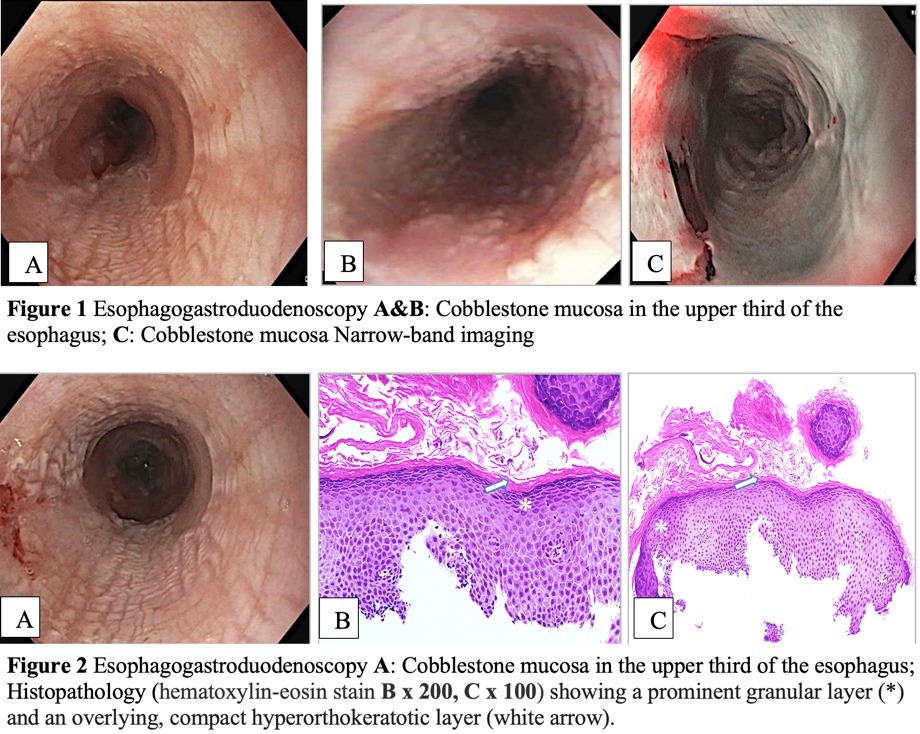Tuesday Poster Session
Category: Esophagus
P4026 - A Rare Case of Esophageal Epidermoid Metaplasia and Its Implications on Dysphagia and Malignant Potential
Tuesday, October 29, 2024
10:30 AM - 4:00 PM ET
Location: Exhibit Hall E

Has Audio

Pearl Aggarwal, MD
University Hospitals St. John Medical Center
Westlake, OH
Presenting Author(s)
Pearl Aggarwal, MD, Saleem Chowdhry, MD
University Hospitals St. John Medical Center, Westlake, OH
Introduction: Epidermoid metaplasia is a rare histological correlate to oral leukoplakia with an unclear association with squamous dysplasia and carcinoma. Our case study offers insights into this association, explores risk factors, and offers management guidance.
Case Description/Methods: A 73-year-old female presented with progressively worsening swallowing difficulty with solids and liquids of 2 years. She was a former smoker with occasional alcohol use. A modified barium swallow study showed upper esophageal stasis. Esophagogastroduodenoscopy (EGD) revealed an intrinsic stricture in the lower and middle thirds of the esophagus. Dilation of the middle stricture from 12 mm to 13.5 mm using a balloon dilator improved scope passage and lumen appearance. Severe cobblestone mucosa measuring 5 cm was seen 20 cm from the incisors(Figures 1-A,B,C, and 2-A). Biopsies of the strictures showed mild acute inflammation and intraepithelial eosinophils. Proximal esophageal biopsy revealed hyperkeratosis and a prominent granular cell layer, suggesting esophageal epidermoid metaplasia(Figure 2-B, C). Following dilation, the patient's symptoms improved, and they were prescribed daily pantoprazole, dietary modifications, and a follow-up in 1 year.
Discussion: Esophageal epidermoid metaplasia, defined by intense granular layer-hypergranulosis with overlying hyperorthokeratosis, was first reported by Nakanishi in 1999. It primarily affects middle-aged older females. Risk factors include tobacco smoking and alcohol intake; dysphagia is a rare presenting complaint. Endoscopically, it presents as white, well-demarcated areas with cobblestoning, commonly affecting the mid-esophagus. ICottreau et al. reported that all cases had concurrent esophagus squamous cell carcinoma. Nakanishi et al. noted adjacent well-differentiated squamous cell carcinoma with submucosal invasion. Ezoe et al. observed synchronous or metachronous squamous cell carcinoma in all patients. Aida et al. demonstrated genomic instability in the lesion, suggesting a potential premalignant nature. Management involves cessation of alcohol and tobacco use, dietary modifications, acid suppression therapy, and surveillance follow-up for malignant transformation.
In conclusion, esophageal epidermoid metaplasia is a rare cause of dysphagia and warrants recognition during endoscopy due to its premalignant potential and association with squamous cell dysplasia and carcinoma. Future studies are needed to establish surveillance guidelines.

Disclosures:
Pearl Aggarwal, MD, Saleem Chowdhry, MD. P4026 - A Rare Case of Esophageal Epidermoid Metaplasia and Its Implications on Dysphagia and Malignant Potential, ACG 2024 Annual Scientific Meeting Abstracts. Philadelphia, PA: American College of Gastroenterology.
University Hospitals St. John Medical Center, Westlake, OH
Introduction: Epidermoid metaplasia is a rare histological correlate to oral leukoplakia with an unclear association with squamous dysplasia and carcinoma. Our case study offers insights into this association, explores risk factors, and offers management guidance.
Case Description/Methods: A 73-year-old female presented with progressively worsening swallowing difficulty with solids and liquids of 2 years. She was a former smoker with occasional alcohol use. A modified barium swallow study showed upper esophageal stasis. Esophagogastroduodenoscopy (EGD) revealed an intrinsic stricture in the lower and middle thirds of the esophagus. Dilation of the middle stricture from 12 mm to 13.5 mm using a balloon dilator improved scope passage and lumen appearance. Severe cobblestone mucosa measuring 5 cm was seen 20 cm from the incisors(Figures 1-A,B,C, and 2-A). Biopsies of the strictures showed mild acute inflammation and intraepithelial eosinophils. Proximal esophageal biopsy revealed hyperkeratosis and a prominent granular cell layer, suggesting esophageal epidermoid metaplasia(Figure 2-B, C). Following dilation, the patient's symptoms improved, and they were prescribed daily pantoprazole, dietary modifications, and a follow-up in 1 year.
Discussion: Esophageal epidermoid metaplasia, defined by intense granular layer-hypergranulosis with overlying hyperorthokeratosis, was first reported by Nakanishi in 1999. It primarily affects middle-aged older females. Risk factors include tobacco smoking and alcohol intake; dysphagia is a rare presenting complaint. Endoscopically, it presents as white, well-demarcated areas with cobblestoning, commonly affecting the mid-esophagus. ICottreau et al. reported that all cases had concurrent esophagus squamous cell carcinoma. Nakanishi et al. noted adjacent well-differentiated squamous cell carcinoma with submucosal invasion. Ezoe et al. observed synchronous or metachronous squamous cell carcinoma in all patients. Aida et al. demonstrated genomic instability in the lesion, suggesting a potential premalignant nature. Management involves cessation of alcohol and tobacco use, dietary modifications, acid suppression therapy, and surveillance follow-up for malignant transformation.
In conclusion, esophageal epidermoid metaplasia is a rare cause of dysphagia and warrants recognition during endoscopy due to its premalignant potential and association with squamous cell dysplasia and carcinoma. Future studies are needed to establish surveillance guidelines.

Figure: Figures
Disclosures:
Pearl Aggarwal indicated no relevant financial relationships.
Saleem Chowdhry indicated no relevant financial relationships.
Pearl Aggarwal, MD, Saleem Chowdhry, MD. P4026 - A Rare Case of Esophageal Epidermoid Metaplasia and Its Implications on Dysphagia and Malignant Potential, ACG 2024 Annual Scientific Meeting Abstracts. Philadelphia, PA: American College of Gastroenterology.
